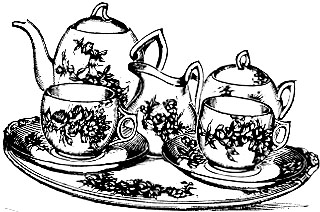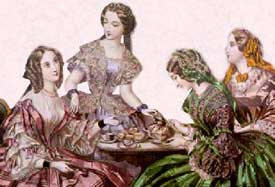 Taking tea in the 1860's may well
have been popularized by Queen Victoria who enjoyed the beverage, but who
had not been permitted the pleasure at a young age. Americans had grown
accustomed to having tea although perhaps not quite to the extent the
British indulged.
Taking tea in the 1860's may well
have been popularized by Queen Victoria who enjoyed the beverage, but who
had not been permitted the pleasure at a young age. Americans had grown
accustomed to having tea although perhaps not quite to the extent the
British indulged.
Tea became a very precious
commodity in the war-time South along with coffee, sugar and other such
items. Flour rose in price so much as to force many Southern civilians to
look for substitutes in corn meal and rice flour. Sorghum, honey, and
even watermelon syrup often sweetened crude makeshift desserts in the
absence of sugar.
Tea was sold in bulk in the
mid-19th century. It wasn't until many years later when a tea salesman
sewed up little bags of various teas as samples for his customers that the
idea of the modern tea bag came into being. Brick tea was available, but
not used as often as loose tea. Loose tea is still preferred for brewing
in the pot today.
Various types of tea were
enjoyed during the period - some perhaps more readily available than
others. Both green and black teas were available as were some flavored
teas such as Earl Grey. Earl Grey tea got its name from an actual person,
Earl Grey, born in l764, and died in l845. It is usually a blend of black
tea and bergamot oil and today is the second most popular tea. Queen
Victoria and Albert's love of all things Scottish led to shops in London
carrying a blend of black teas which later became known as English
Breakfast.
 A "tea" during the mid-19th
century did not necessarily mean the social occasion we think of today.
It might have meant simply a light supper for family and/or close
friends. When people got together for tea it was generally a small
gathering with china cups, china or silver teapot, etc. Today if living
historians gather for tea and a light meal or refreshments the same should
be taken as a matter of course. The idea of taking tea being for women
only is a modern notion.
A "tea" during the mid-19th
century did not necessarily mean the social occasion we think of today.
It might have meant simply a light supper for family and/or close
friends. When people got together for tea it was generally a small
gathering with china cups, china or silver teapot, etc. Today if living
historians gather for tea and a light meal or refreshments the same should
be taken as a matter of course. The idea of taking tea being for women
only is a modern notion.
Tea houses and the associated
ceremony of taking tea evolved sometime during the late nineteenth
century. Southern women who kept war-time journals often mention tea
- either the lack of it, or when it was available the drinking of it.
Entries I have encountered seemed to refer to family members and sometimes
guests gathering for a light meal. When tea was not available substitutes
were brewed up from holly leaves, yaupon, blackberry leaves, raspberry
leaves etc., the latter having been served in Europe during the century
before.
Below please find some simple receipts of the day which might have found
their way to the table as an accompaniment to
tea. Lemons would have been rare in the war-time South so
perhaps it might be more authentic to sweeten the cup
with a bit of honey and perhaps a little milk.